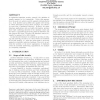Free Online Productivity Tools
i2Speak
i2Symbol
i2OCR
iTex2Img
iWeb2Print
iWeb2Shot
i2Type
iPdf2Split
iPdf2Merge
i2Bopomofo
i2Arabic
i2Style
i2Image
i2PDF
iLatex2Rtf
Sci2ools
SIGMOD
2004
ACM
2004
ACM
The Role of Cryptography in Database Security
In traditional database security research, the database is usually assumed to be trustworthy. Under this assumption, the goal is to achieve security against external attacks (e.g. from hackers) and possibly also against users trying to obtain information beyond their privileges, for instance by some type of statistical inference. However, for many database applications such as health information systems there exist conflicting interests of the database owner and the users or organizations interacting with the database, and also between the users. Therefore the database cannot necessarily be assumed to be fully trusted. In this extended abstract we address the problem of defining and achieving security in a context where the database is not fully trusted, i.e., when the users must be protected against a potentially malicious database. Moreover, we address the problem of the secure aggregation of databases owned by mutually mistrusting organizations, for example by competing companies.
| Added | 08 Dec 2009 |
| Updated | 08 Dec 2009 |
| Type | Conference |
| Year | 2004 |
| Where | SIGMOD |
| Authors | Ueli M. Maurer |
Comments (0)

